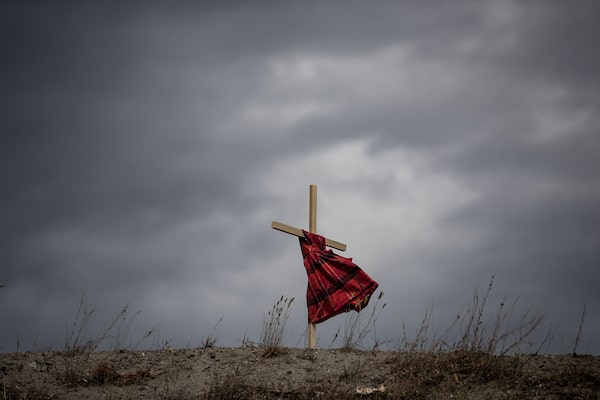
A child's dress hung on a cross blows in the wind near the former Kamloops Indian Residential School, to honour the 215 children who were discovered buried near the facility, in Kamloops, B.C., on June 4, 2021.DARRYL DYCK/The Canadian Press
Catholic Church officials improperly redirected funds meant for residential-school survivors toward administrative costs and legal fees, government documents alleged during a 2014 court fight between federal lawyers and the church.
The allegations are contained in a federal factum, one of several court documents obtained by The Globe and Mail. The court case began as a dispute over funds the government said were owed by Catholic organizations under the residential-schools settlement.
In a decision the following year, the judge in the case ruled that Catholic entities were released from their remaining settlement obligations.
The Globe has requested access to the court records for the case, but they haven’t yet been made available. The CBC has previously reported that it has also requested access.
Will accountability ever come in the Catholic Church and the Canadian government?
Part of the court file obtained by The Globe reveals disputes over accounting practices, legal fees, interest payments and shortfalls in Catholic funding meant for Indigenous healing programs. The disclosures come after the recent discoveries of more than 1,200 unmarked graves near several former residential-school sites, which have triggered renewed calls for reparations from the Catholic Church.
Canada’s residential schools operated for more than a century, with about 150,000 First Nations, Métis and Inuit children separated from their parents; many were forbidden from speaking their language and practising their culture. The Truth and Reconciliation Commission has called it a policy of cultural genocide.
As part of the Indian Residential School Settlement Agreement reached in 2006, Christian denominations responsible for operating Canada’s residential schools agreed to pay restitution. The Catholic Church, which operated roughly 60 per cent of residential schools, had the largest set of financial commitments.
Those included a $29-million cash payment, 80 per cent of which was to go to the Aboriginal Healing Foundation, an Indigenous-led national organization; $25-million of in-kind services provided by the church; and an additional $25-million in a “best efforts” national fundraising campaign.
The federal government, which funded most residential schools, itself paid $3.23-billion in compensation to survivors and other costs as part of the settlement.
In 2009, the Catholic Church incorporated a special charity, the Corporation of Catholic Entities Party to the Indian Residential Schools Settlement (CCEPIRSS), meant to receive and disburse funds from the 54 dioceses, religious orders and congregations that were part of the settlement.
But according to the government’s court submissions, church officials violated the terms of the settlement agreement by reallocating funds meant for reconciliation and healing. Ottawa’s court filings called the move “shocking,” and argued that Catholic officials had “taken a novel approach to accounting.”
A May, 2014, document summarizing Ottawa’s position alleged that while the various Catholic bodies in the settlement had forwarded sufficient amounts to cover payments to the Aboriginal Healing Foundation, CCEPIRSS had deducted administration fees before those funds were sent out the door. That was in violation of the settlement agreement’s terms, the government said. Those deductions led to a $1.6-million shortfall, lawyers said, and by the time the court case began in 2014, roughly $30,000 was left in the Catholic organization’s accounts.
Meanwhile, CCEPIRSS had paid out millions in fees, government lawyers said, including $2.7-million in consulting and legal fees to the law firms of two lawyers who sat on the organization’s board.
The government also said CCEPIRSS could have paid administrative fees using interest from the Catholic entities’ funds, but their contributions had generated barely any interest. Out of a $14.6-million pot, the organization earned only $6,252, documents say – a 0.04-per-cent rate of return.
In an affidavit, a federal public servant called the low returns “incomprehensible” and “far less than what was expected.” Using the Bank of Canada’s interest rates, they calculated the corporation could have made more than $134,000.
The government also took issue with the $25-million of in-kind services claimed by CCEPIRSS, saying the organization’s auditor had seemingly not audited records for those claims and had “no basis on which to value the services.”
Grouard-McLennan Archbishop Gérard Pettipas in Alberta, former chairman of CCEPIRSS, did not respond to The Globe’s request for an interview, but did give a statement to the Catholic Register on Wednesday that touched on the legal affairs surrounding the residential-schools settlement.
“[It] was a legal agreement,” he said. “And even though I understand that lots of people were frustrated by how many lawyers had to be involved in this as it went on through history, it was a legal agreement.”
James Ehmann, one of the lawyers who had represented CCEPIRSS during the case, told The Globe there was more to the case than just the government’s claims. “It was not a situation of the government saying simply, ‘You bad boys, you did these things improperly or irregularly,’ and the Catholic entities saying, ‘Oh, you’re right,’ ” he said. “There was a real bone of contention over all of that.”
Mr. Ehmann said he could not comment further without reviewing court files.
In an interview, Mike DeGagné, former executive director of the Aboriginal Healing Foundation, said, “You can’t pay your lawyers out of a settlement. That money belongs to Indigenous people.”
While Mr. DeGagné sat across from various churches and government officials as part of the settlement process, the Catholic Church stood apart. “These people are as obstructionist as any you’ll ever work with,” he said.
“If you had the United Church at the table, you often had a minister, and that minister’s file was the residential-school settlement,” he said. “When you met with the Catholic Church, you saw their lawyers. Their stance from the very beginning was to defend themselves and hold themselves blameless.”
The court case eventually morphed into something different entirely.
In June, 2014, CCEPIRSS lawyer Gordon J. Kuski attempted to strike a deal with Ottawa to pay back some of what was owed to the Aboriginal Healing Foundation, according to the court files.
But a dispute soon emerged between Mr. Kuski and government lawyer Alexander Gay over whether Ottawa had agreed to settle the case. Mr. Kuski said the government had made a deal over e-mail. Mr. Gay, the government’s lawyer, said it had not.
“Until and unless we can come to agreement on the terms of the release, there is no agreement,” Mr. Gay wrote to CCEPIRSS and Mr. Kuski late in 2014. “Your suggestion that there is an agreement is disturbing on many fronts and an unfortunate move on your part.”
For another eight months, CCEPIRSS and Ottawa fought over whether a deal had been struck. In the summer of 2015, Saskatchewan Court of Queen’s Bench Justice Neil Gabrielson ruled that the government had indeed agreed to a deal.
That decision released the Catholic Church of its remaining commitments under the residential-schools settlement. CCEPIRSS was wound up soon after that, and ceased its activities in 2016, according to Canada Revenue Agency financial records.
Our Morning Update and Evening Update newsletters are written by Globe editors, giving you a concise summary of the day’s most important headlines. Sign up today.
 Tom Cardoso
Tom Cardoso